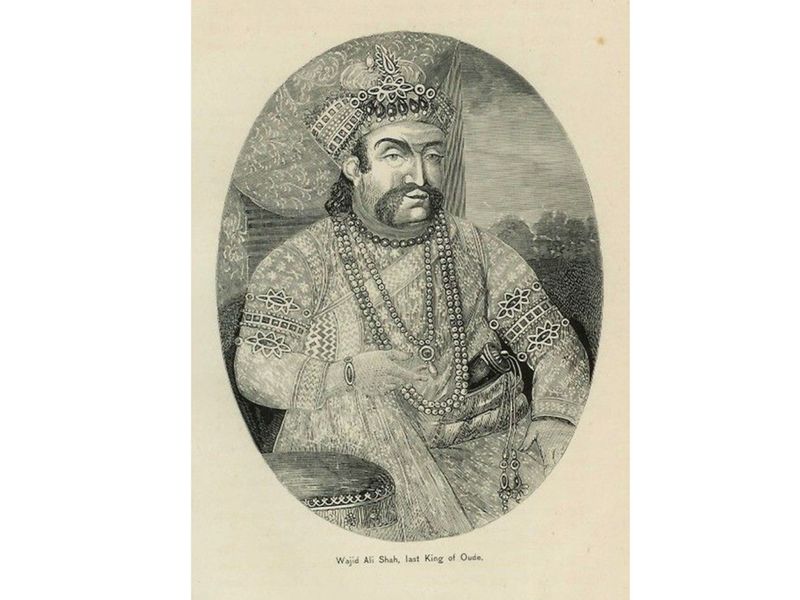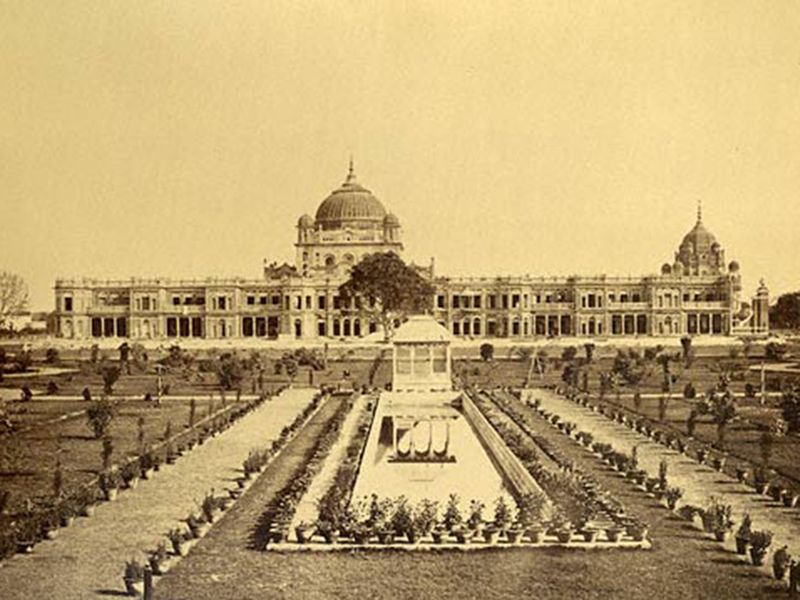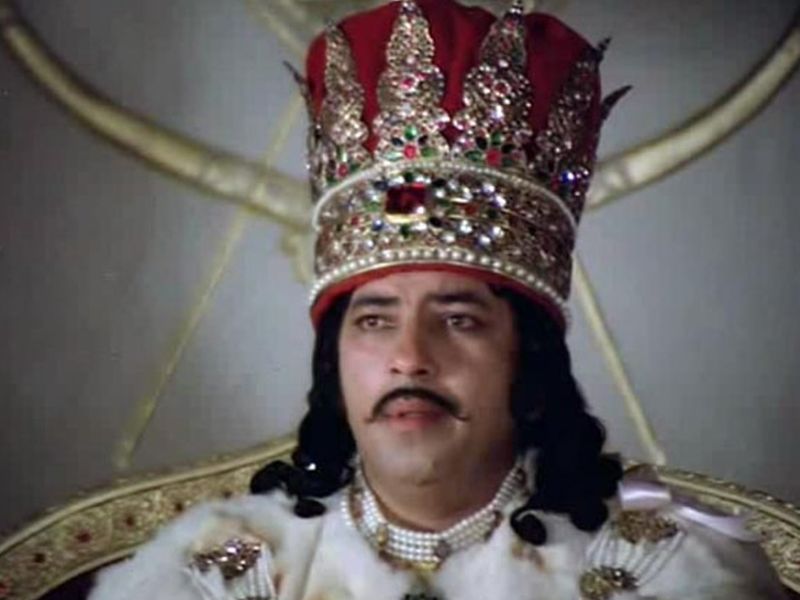
In a confessional scene lasting onscreen for about four minutes in Satyajit Ray's National Award winner “Shatranranj Ke Khiladi” (The Chess Players,1977) Nawad Wajid Ali Shah, the tenth of Awadh speaks his mind.
Shah confesses in chaste Hindustani, that he “wasn’t fit to be a king”, as he finishes humming a soulful Thumri (a light classical form of Hindustani Music) he had once penned! The onscreen confession raises a doubt about his efficacy as a ruler but the very next moment with the soliloquy of the king, one is led to think how he was a “constant thorn” for the British government, a popular king least authoritarian, ryot (native peasants) loving, a brilliant poet, interested in aesthetics of all kinds, architecture, dramatics, music, dance and culinary.
In many ways, the ‘self-contradictory’ onscreen confession would not extrude Shah all his life beginning in 1847 when he ascended the throne of Awadh, a prosperous Eastern Gangetic province that rose into prominence in late Mughal period, creating its own niche.

The Shah's bicentenary
Reflecting on his bicentenary birthday (July 30, 1822) one is gripped at the complex, syncretic, liberal, seemingly contradictory king’s persona and the undeniable footprints he had left on the cultural front of India, which has turned out to be relevant even in current times.
In reality, Shah’s brief rule was marked by people friendly administrative measures. In 1848, a year after he took charge, Shah initiated land revenue reforms, recruited administrative staff who happened to be also musicians.
Both these decisions were vehemently criticized by British Government but it really did not deter Shah, on the contrary he continually resisted British aggression, putting his foot down on Governor General Dalhousie and General Outram’s plan to annex Awadh. Despite his resistance Awadh was forcibly annexed in early 1856.
Before the takeover, the king left Lucknow for Kolkata erstwhile Calcutta. The next thirty-one years of his life would be checkered visa-vis how he led his life in Kolkata while constantly posing a headache for British government, who despite several attempts could never curb the free-spirited king, who refused to bow to the changing political times that would impacted him existentially.

Away from the rhetoric, largely promoted by the British and later empire pacifists, Shah is an unconventional hero, whose life has uncanny resemblance with Greek tragic character Orpheus, one of the greatest bard of classical Greek mythology.
Like Orpheus it is poetry and music that gave Shah his inner strength and much like the Greek bard Shah’s literary self would also become a reason for him branded as a ‘unfit’ ruler.
His regime inextricably connected to India’s miserable fate thereafter with great uprising crushed, leading to colonial rule in its fullest, yet Wajid Ali Shah must be celebrated on more than one account, more so in the context of current times of South Asia, wherein finding a diehard anti colonial, syncretic, artistic, pro people administrator is a rarity.
Situating Wajid Ali Shah
Awadh came into prominence around early 1700s the same decades when the federal Mughal court at Delhi had begun to decimate. It was one of the three breakaway states, other two being Bengal and Hyderabad. Interestingly the newly emergent seats of power were all led by men who rose from within the workings of Mughal Empire.
By 1722 Awadh became independent under Borhan al-Molk Mir Mohammad Amin Musawi Sa`adat Ali Khan popularly known as Burhan–ul–Mulk. Awadh became a newer power base with ambitious Mulk its leader.
The kingdom also started developing a distinct court culture that was rooted in the Indo Persianate ethos, along with the local cultural manners of northeastern Uttar Pradesh commonly referred to eastern Gangetic plains.
Once Delhi was up for grabs by the East India Company in 1803, a large group of intelligentsia earlier based in Mughal court and its peripheral circles moved to Lucknow. The exodus included artists of all kinds, craftsmen, jewelers, musicians, dancers, gourmet cooks (rakabdars), cooks and more.
By the time Wajid Ali Shah ascended the throne in 1847, the new provincial power base had transformed in to a byword for ‘culture’. There was conducive environment for liberal arts and the king was at its centre.
Once Shah took over, everything became aplomb with finest of craftsmanship. Awadh aesthetics from its enamel, glass, metal work to its textile art including zardozi, and legendary Chikankari was drawing attention.

Shah himself was deeply attached to poetics, music and yes dance an attribute that was defined as ‘non masculine’ in popular understanding. Abdul Halim Sharar, a contemporary chronicler writes, “His association with dissolute women, singers, dancers continued to increase.” Sharar concludes that his learning was more from this class than from the courtly elite ones. He isn’t too off the mark for king stroke an interesting balance between his kingly duties and his artistic self.
He was attentive towards army reforms, formed new cavalry regiments and helmed the affairs dispensing justice to his people. On days when he would go on rounds, there would be two silver boxes on the preceding horses and anyone in his rule could file a petition of complaint and drop it in those boxes.
Later the king who held the keys of the complaint boxes, would respond to each petition, resolving them best. If this was anything to be noted, then Shah was nearly as able and pro his subjects like Akbar or even Sher Shah but unlike them Shah was honestly was more aligned to creative, intellectually stimulated hedonistic life. He knew this more than any of his courtier or even his wives and thus never denied of his supposed ‘shortcomings’.
Poetry, plays, music and architecture
His love for poetry, plays, music and architecture went on simultaneously as if they were complimentary to each other. In 1848 Shah began writing a fully illustrated and illuminated manuscript or masnavi in Nasta’liq script called ‘Ishqnama’ or the Book of Love that would have his youthful autobiography documented in Urdu, with 103 folios painted in watercolours with gold for the borders, similar to Persian aesthetics of miniature paintings. The same year or a year later Shah began building Qaiser Bagh, a stunning palace complex where he would reside until his exodus from Awadh-Lucknow.
To that he was also building battalions denoting them with poetic names like Banka: Dandy, Tircha: Fop and Ghangaur: Dark as well as dealing with British officials like William Sleeman who was appointed as the British Resident at Court, General Outram and Governal General Dalhousie who was on his mission of annexing Awadh. In all likelihood it was Dalhousie’s and Outram’s version of Shah that percolated to public imagination long after colonial regime ended. Despite this negative imaging Shah remained terribly anti colonial till his end.
His anti-colonialism found expressions in the world he built around himself what he held close to his heart, music – thumri a light classical form that he nurtured, his ghazals and dramas, resulting into two volumes of prominent literary works titled Diwan-i-Akhtar and Husn –i-Akhtar containing, poems, prose, ghazals. Fascinatingly he used more than one nom-de-plume like “Qaisar” and “Akhtarpiya".
Records helmed by his courtiers tell us how Thumri was gaining its identity as a new form of classical music as was Kathak a unique dance form that originated in ancient times and was commonly used by travelling storytellers or Kathakars (a Sanskrit word). The latter performative art of telling stories got a new boost during Bhakti Movement picking up the devotional narratives of Hindu Gods like Krishna.
Shah gave it a fresh lease of life encouraging it to be practiced in his court, in fact he became a performer of this emotive storytelling and each year performed Rahas (a term he had coined) or Rasleela (stories of divine couple Radha-Krishna) adorning the role of Kanhaiya or Krishna himself.
He would dress up exactly how the Hindu deity has been depicted in the texts with all the fineries from head to toe. Soon the royal Rahas would become an annual event, a spectacle for all of Awadh cutting across faith, class, caste. The grand celebrations would take place in the Baradari (a lounge or pavilion with twelve doors and distinct acoustic features) of Qaisar Bagh, a space that the king had built for such eclectic performances.
In retrospect such syncretism was ahead of its time, no wonder it is the same region that has till today held ‘Ganga- Yamuna Tehzeeb’, a cultural discourse that has diversity at its heart.

The Shadow Never Faded
The colonisers could not handle Shah, while he never confirmed – thus it was best for the former to create an image of utter misadministration and they did so by masterminding reports leading to the annexing of Awadh in 1856 coercing Shah to sign a treaty and rest is history.
The next thirty-one years would be a complex trajectory of living in exile in present day Kolkata’s neighbourhood called Metiaburj (the mud tower), with initial two years of serving punishment at Fort William. Rest of the time was spent by in recreating Lucknow in Metiaburj in all earnest. It would be a nuanced and exhausting process all at once, eventually creating a miniature Lucknow.
The full bodied life that the king enjoyed at Metiaburj was also emerged from the contribution by all who followed him from Awadh to Calcutta, as a mark of their unfettered love for the maverick king.
On the two hundred year of his birthday, it would be hard not to love the king whom the British decided to purposefully brand ‘unfit’ for they did not have a box to fit him in. In a fascinating scene in Shatranj Ke Khiladi, twenty minutes into the film Outram is shown inquiring for more information about the devout, exceptional ruler of Awadh.
He asks his one of his officers, “Weston, I hear the King is a poet, what kind of poems does he write, I also hear that between his prayers in the afternoon he flies kites on the roof of the palace, is it true?”. Weston responds eloquently by reciting and translating one of Shah’s couplet, exclaiming how beautiful it is if one knows the language read Urdu in which it is written and how much people adore the king’s poetry.
I pondered on his birthday how many poet, dramatist, musician, dancer, lover of finest food (credited for Kolkata Biriyani) and die hard patriot has the subcontinent witnessed in last two hundred, tackling whom was complicated even for the most oppressive East India Company and later the colonial government.
I doubt there were not too many!
Nilosree is an author, filmmaker




